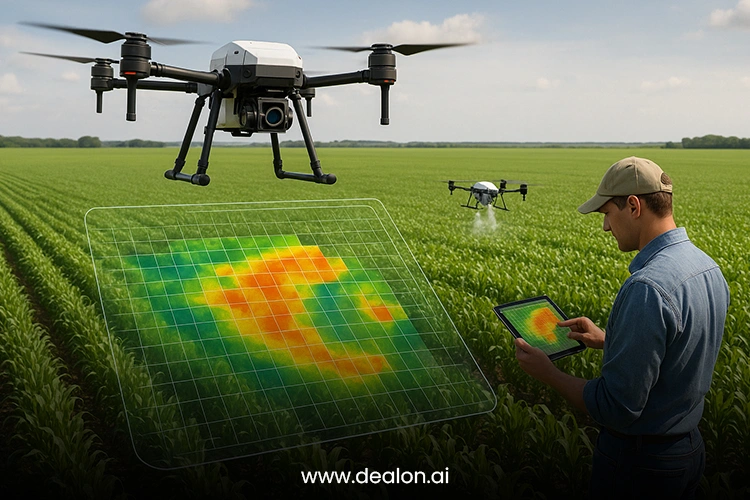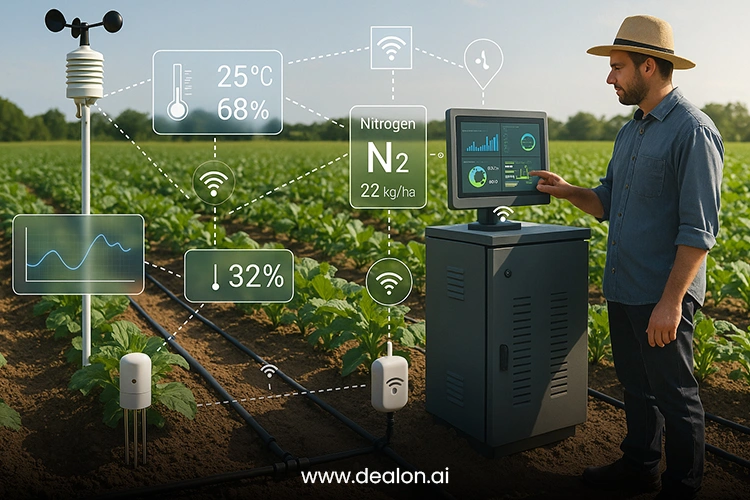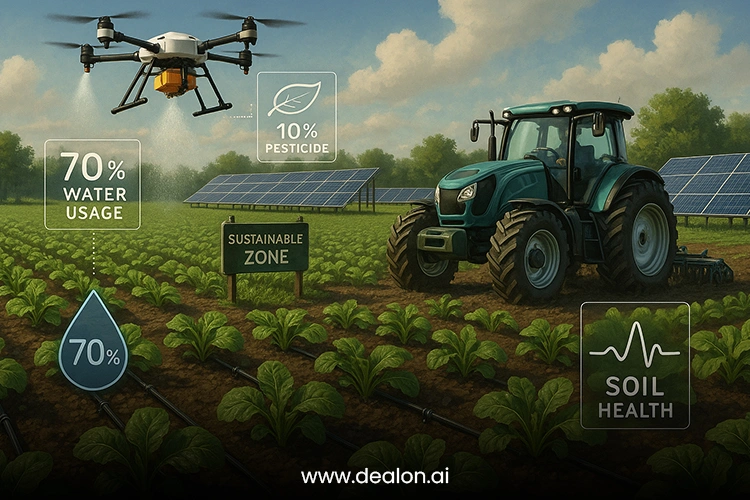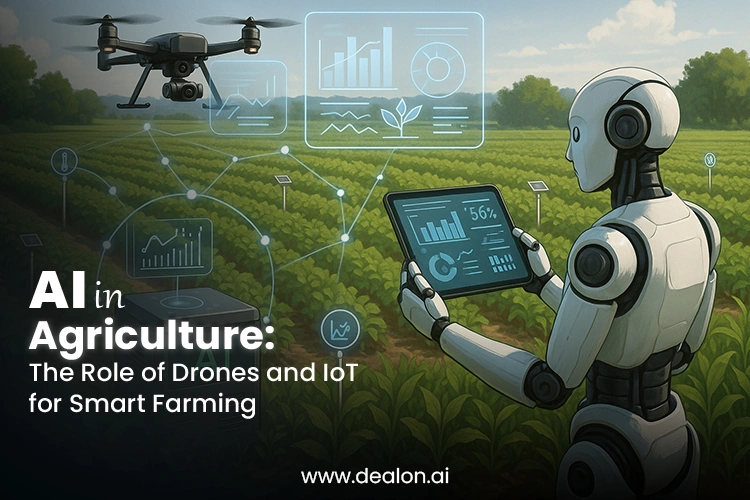Because of recent advancements in AI, drones, and IoT, farmers can adopt more innovative and more efficient farming methods. Because more pressure on food supplies and climate change makes crop production harder, these technologies ensure food will always be available. The use of AI, self-driving drones, and IoT-aware sensors has not only improved ways of farming—it has transformed crop management, watering, pest control, and how resources are managed.
AI supports agriculture by automating various tasks and applying machine learning to analyze large volumes of real-time data. Using data helps farmers decide how to work more efficiently and, at the same time, protect the environment. Thanks to drones, farmers can access s-eye images that tell them much about their soil, crops, and drainage areas. Continuous information from these IoT gadgets within farm touchpoints supports better decision-making and leads to more effective work.
Because of these technologies, farms can work more efficiently and become more environmentally friendly. AI, drones, and IoT bring together to help farmers view resources, improve how they grow, detect when their crops are infected, and thus care for the environment and improve farm sustainability. Combining AI, drones, and IoT will change how farming is done for years.
Also Read: AI in Biotechnology: Revolutionizing Gene Editing and Gene Therapy for Future Treatment
The Intersection of AI, Drones, and IoT in Agriculture
Mixing AI, drones, and IoT has opened the door to a more efficient and sustainable way of farming for the future. Combining these technologies makes the ecosystem highly interactive and gives farmers access to data insights when needed. As a result, precision agriculture develops, ensuring actions are based on highly accurate knowledge to save resources.
AI algorithms lead the transformation. AI devices review the data collected by IoT sensors and drones and understand patterns complex for humans to notice. AI can predict crop health and soil water use, which helps farmers prepare for possible risks and new opportunities. AI can help detect pests and diseases, using visual and environmental data from drones to start early action that protects the crops.
Drones are significant in this approach. Flying over the fields and crops allows them to create detailed maps and models that expose minor issues with plants, nutrients, and water. Aerial surveys let farmers find problem spots and apply fertilizers or pesticides to those areas with incredible exactness. Likewise, sensors connected to the farm throughout, from the soil to the equipment, collect information continually, allowing farm managers to see a live digital model of everything. Because of this continuous feedback, farmers can make decisions quickly and improve all aspects of farming.
Agriculture benefits a lot from the trifecta of AI, drones, and IoT in terms of production and following sustainability goals. This leads to more modern, tough farming and uses fewer resources, making it suitable for solving global issues.
Drones: The Eyes in the Sky for Precision Agriculture

Because they can view a whole field from above, drones have grown into a significant innovation for agriculture. Agribots use high-quality cameras, infrared sensors, and sophisticated imaging gear to get detailed views from the overhead of farmland. From this view, farmers can make the best decisions for managing their crops using precise methods that were not available before.
Drones are being used in agriculture mainly for closely tracking crop growth. High-resolution photos and drone thermal data can help find small changes in crop conditions that may go unnoticed without assistance. They let farmers spot early signs of pests, diseases, and too little water so they can act before serious harm is done. Through their aerial view, drones find places in a crop field where nutrients or diseases are affecting plants, and these areas can be treated accordingly.
Drones are also crucial for applying sprays with great precision. Thanks to AI, drone technology is accurate in applying fertilizers, pesticides, and herbicides. Conventional ways can mean spreading too many harmful and expensive chemicals. Drones are distributed only to the necessary areas, which helps reduce costs and waste and decreases environmental risks. This contributes to better farming practices since chemical runoff is hugely reduced and water sources are protected.
They are also great at carrying out field mapping and surveying tasks. GPS and imaging technology generate highly accurate maps and 3D charts of farm areas. They support farmers in arranging crops, improving watering systems, and understanding how the land varies for better soil care. It makes it easier for businesses to work efficiently and prepares for careful future land-use decisions.
Using drones in farming supports the growth and improved productivity of agriculture. Drones keep collecting data and delivering analysis which helps farmers improve their yields and protect the environment through precision farming.
IoT: Empowering Smart Farms with Data-Driven Insights
Farmers now have unprecedented data thanks to IoT, which connects various sensors and equipment to share information in real-time. Because of IoT enablement, soil sensors, weather stations, and irrigation controllers can alert farmers about farm conditions, leading to informed decisions, more innovative use of resources, and more efficient operations. Agriculture moving towards the Internet of Things (IoT) has led to the rise of smart farms powered by specific agricultural data.
With IoT, farmers can get information from the field as it happens. In the soil, IoT sensors continuously monitor the presence of moisture, the temperature, and the various nutrients they share with farmers through continuous updates. Being able to see changes as they occur lets farmers adapt fast by changing irrigation or applying fertilizer only where it is necessary. They can monitor the environment and make better farm decisions through IoT, improving their crops’ health and raising productivity.
Getting proper irrigation is another excellent advantage. Applying water uniformly to fields with traditional irrigation is often a waste because the soil might not require it. In these irrigation systems, sensors measure soil moisture and weather, which automates watering. They direct water only when and where necessary, leading to much less water being wasted and more sustainability. This irrigation method helps save a vital resource and makes farming more affordable.
Tracking livestock is one more critical way that IoT is used in farming. Smart collars and on-body sensors allow farmers to detect when their animals are moving, what they eat, and their behavior. Animals are monitored for early symptoms of disease or anxiety with help from these devices. Thanks to this information, animals can be cared for more proactively, helping their well-being and the farm, than directly rising.
When farmers use IoT and gather information, they can better handle their farm crops, preserve resources, and lessen the cost of farming supplies. IoT is needed to create a sustainable, efficient, and strong food system when farming depends on data.
AI-Driven Analytics: Turning Data into Actionable Insights

Because of AI, vast amounts of data from drones, IoT gadgets, and sensors can now be used to make better farm decisions. Thanks to MLAs and predictive analytics, AI supports farmers as they leave traditional techniques and improve their efficiency, sustainability, and productivity. AI helps farm data analysis by uncovering unnoticed trends and patterns so that farmers can decide what to do in advance to optimize each part of farming.
A significant use of AI in smart farming is through predictive analytics. Forecasting outcomes in farming are accurate for AI because they look at weather, soil conditions, and data from previous crops. Understanding climate data helps farmers foresee possible challenges such as droughts, floods, or temperature changes, which allows them to plan well. For example, AI can tell when farmland needs watering and the best crop harvest time, minimizing waste and cutting costs.
AI is also very effective at spotting issues like crop diseases and pests. Using both information from AI algorithms and data gathered from drones and IoT sensors, it is possible to find diseases and pests affecting crops. This method enables farmers to solve issues faster because the problems are noticed early on. AI can detect patterns in data to determine if crops are healthy or diseased, often providing greater accuracy than human visual inspections.
Yield prediction also depends a lot on AI. AI can forecast yields efficiently by looking at several inputs like weather forecasts, soil readings, and earlier trends. This makes it possible for farmers to check their stock, pick the right time to harvest, and minimize food loss. Moreover, the insights produced by AI guide farmers in setting up better crop rotations, which gradually enriches the soil and leads to larger harvests.
Farmers can use AI tools to collect and examine large amounts of data that support better, more environmentally friendly agricultural practices. The agriculture sector will use AI analytics to make better and more informed decisions.
Smart Farming for Sustainability: Reducing Environmental Impact

Using advanced technology like AI, drones, and IoT in smart farming makes farming easier, friendlier to the environment, and more productive. Using much water, excess fertilizers, and careless pesticides in traditional farming has substantially stressed the environment and its resources. When they apply innovative technologies, farmers can manage their crops more easily, discard less, and save the environment, making it possible for more sustainable agriculture.
Smart farming greatly helps in saving water. With the sensors placed in the soil, moisture is constantly watched, and watering is performed only when needed. This tight management of water prevents it from being wasted which is especially important in water shortage regions. Rather than having leaked or evaporated water, IoT-enabled irrigation sends water to crop roots so that only a little water is used, but there is a larger crop yield.
Farmers benefit from smart farming because it lowers the chemicals they use. Using AI, drones can accurately spray fertilizers, pesticides, and herbicides to parts of the farm that need them. Because chemicals are only applied where necessary, there is much less chance of nearby water systems becoming contaminated and surrounding nature being damaged. Because drone technology is so precise, it lowers the amount of chemicals applied to the soil, which helps the soil, crops, and wildlife stay healthy.
Additionally, farmers can use AI to create sustainable ways to use land for farming. AI can review data gathered by drones and IoT devices to check the health of crops, spot missing nutrients, and see what is happening in the fields. Because of this data, they can use responsible methods for crop rotation and land use that keep the soil healthy, help nature thrive, and boost their long-term output.
Using smart farming gives us new methods for food production and allows farmers to act in ways that reduce their effect on nature. Water conservation, less use of chemicals and improved land use enable these technologies to support sustainable agriculture for future people.
The Future of AI in Agriculture: A Path to Smarter, More Efficient Farming
The future of AI in agriculture will significantly enhance the current technologies helping farmers. Even though AI, drones, and IoT are currently beneficial, we have just entered the first stage of what they can do. With ongoing technological improvements, innovative farming systems will give farmers better resources to increase productivity, make farming more sustainable, and improve how things are done.
Advanced AI systems are expected to work with more data soon, improving how they predict and manage farming operations. Future advanced AI could study weather and soil systems and accurately predict crops’ development. With predictive abilities, farmers will observe early warnings of pest invasions, periods of severe drought, or changes in the market, which they can use to manage risks appropriately and be more prepared.
AI and the progress of drones will take the accuracy of precision agriculture to new limits. Because drones carry bigger loads, stay in flight longer, and use better sensors, they can observe and scan much larger areas of farms. Working with modern technologies such as hyperspectral or LiDAR (Light Detection and Ranging) reveals many details about plant health, what’s in the soil, and invisible side effects affecting plants.
Also, with autonomous tractors and AI-powered harvesters, we will begin to see automation playing a significant role in farming. They are programmed to keep working non-stop, planting crops, watering them, and collecting them without requiring many people to do manual work. Agriculture will see robots assisting with farm tasks such as weeding, checking crop health, and looking after animals.
With smart farming being more affordable and available, it will overhaul farming worldwide. It is possible for farmers to use fewer resources, produce the best crops and create less impact on the environment. AI has the potential to make our food production more sustainable, prosperous, and profitable for farmers, entering a new era for the industry.
Conclusion
By using AI, drones, and IoT in farming, farming methods become more effective, sustainable, and intelligent. Such technologies help farmers use resources, work more efficiently and have less effect on the environment. Crop health improves, and waste is reduced thanks to drones, which monitor crops accurately, detect illness early, and apply chemicals precisely. With IoT, information about soil, water, and livestock health is collected in real-time, which helps farmers make the best decisions.
AI helps process a lot of data so that farmers get advance notice about problems and how to improve their harvests. These advancements can do more than they are now, with tractors driving themselves, AI collecting harvests, and robots helping farmers. Because these innovations are now available and more affordable, smart farming will help achieve sustainable and profitable agriculture.
In the long run, AI, drones, and IoT will shape the future of precise farming for agriculture. If these technologies are adopted, farming will become more efficient, have less effect on the environment, and secure sustainable food for everyone in the future.


zoritoler imol
Great write-up, I’m regular visitor of one’s web site, maintain up the nice operate, and It’s going to be a regular visitor for a lengthy time.